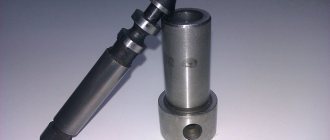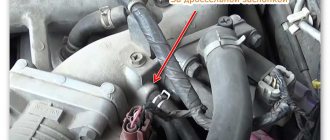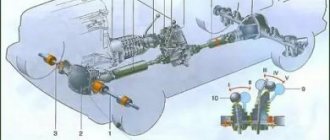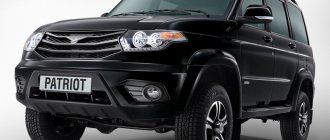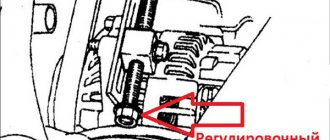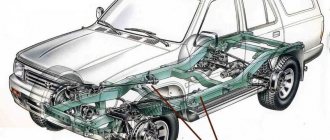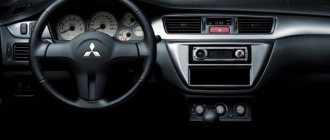The vehicle's handling, obedience, and even free space in the trunk and interior largely depend on the car's drive.
What the drive should be like and how to choose it, not all car owners are able to figure it out. And modern labeling and abbreviations only further add unnecessary confusion to this issue. If we consider all the markings that exist today, you can make the wrong choice and purchase a car with completely different qualities than what was planned. After all, there are RWD and FWD drives with different descriptions, and which one you need is worth thinking carefully about.
FWD drive, what is it in a car? This abbreviation is not clear to many people. Therefore, this article will be devoted to the concept of FWD, what this component serves in a car and what advantages and disadvantages it has.
The abbreviation FWD and how to understand it
FWD is, as you probably already understood, a kind of drive. However, several concepts may be hidden under such an abbreviation. We will look at the main two of them. The first is Full Wheel, which means that all the wheels of the car are driven, that is, the car is all-wheel drive. And the second option is Front Wheel Drive, in which only the front axle is driven.
Today there is no clear concept of this type. But the main and often used one can be called FWD (Front Wheel Drive), which stands for front-wheel drive or all-wheel drive. Accordingly, this also applies to axles, either the drive is on the front axle only, or on two drive axles at the same time.
At the same time, the same abbreviation can mean another option - rear-wheel drive in the name, but only one letter will change - RWD or FWD. It’s difficult to say which of all three is better; some car owners like them like this, others like them differently, and imposing our own opinion is not part of our plans. We just want to figure out what's what and bring clarity to car owners.
Be that as it may, most drivers currently drive front-wheel drive. Firstly, front-wheel drive appeared a very long time ago and was based on the traction force on the principle of a horse cart, which was used in the old days.
Secondly, we cannot help but say that both the engine and transmission can be easily installed under the hood of the car, while emptying the rear part for some cargo, seats for passengers and even part of the fuel tank.
Thirdly, due to the parameters already mentioned, such cars are considered budget-friendly and easy to manufacture, which cannot be said about rear-wheel drive cars.
But is everything as beautiful as it might seem at first glance, or are there some pitfalls here that we’ll have to figure out?
Types of FWD systems
There are different types of all-wheel drive transmissions. You can most often find adaptive all-wheel drive on SUVs, sports cars, crossovers, and even some minivans. This system is capable of distributing engine power between the rear and front wheels if necessary. In most cases, 100% of the power is sent to the front wheels first, but the system senses a loss of traction and shifts power to the rear axle. Moreover, power is not always distributed in a 50/50 ratio.
All-wheel drive is the simplest transmission system, which is implemented on SUVs such as the Jeep Wrangler and the Russian Niva. There is a special transfer case with which you can connect or disconnect the front axle from the transmission. That is, the car drives on rear-wheel drive most of the time, but when the driver notices a loss of traction, he can connect the front axle using a lever in the cabin.
Permanent all-wheel drive is rarely used in modern cars. Here, neither the driver nor the computer can connect/disconnect, or move the torque transmission to different axles.
Advantages of front-wheel drive
1. In front-wheel drive cars, the engine is placed across the car, due to which the rotation of the crankshaft is immediately transmitted to the wheels.
It turns out that the number of torque adapters drops sharply, which cannot but be called an advantage for the operation of the equipment. 2. You can even be proud of the front drive axle with this configuration. After all, it takes the entire load of the car on itself, although the mass of the engine is considerable. In this case, it turns out that the driving axle itself and traction with the road are ensured in the best possible way.
Regardless of the weather, driving a front-wheel drive car will be much easier. It is controllable and obedient even in snow and ice. But owners should not increase the speed in such weather, as this risks causing the car to skid at speed.
3. As mentioned above, we owe front-wheel drive for the free space under the hood and even in the cabin, as well as the fact that the cost of such a car is more affordable than with rear-wheel drive.
Types of vehicle drives
Let's take a closer look at each type of drive, and also analyze the advantages and disadvantages.
R.W.D.
The use of such a drive creates the following advantages:
- Easy turning due to the small radius. This is achieved due to the fact that the front wheels are not limited to a complex drive axle system.
- Even in the case of an independent rear suspension, the car does not need to install constant velocity joints.
- A controlled skid that can be quickly localized by turning the steering wheel in its direction and adjusting the speed.
- Lightweight steering due to the absence of reactive torques.
- Good acceleration dynamics and confident climbing.
- Valued by reckless drivers and fast and furious fans.
- Optimal weight balance.
When driving, the weight of a vehicle with RWD is transferred to the rear wheels, as a result of which the car receives better traction and acceleration dynamics are improved.
Alas, along with the advantages, there are also disadvantages. There are fewer of them, but they are disproportionately more significant:
- Insufficient controllability on a problematic road. This is especially felt when there is ice and on damp soil. To optimize control, the installation of more advanced stabilization and traction control systems will be required. Expensive profile rubber can partially improve this problem.
- RWD vehicles typically cost several times more than their front-wheel drive counterparts. This paradox is due to the complicated design of the transmission and expensive chassis parts. This key circumstance must be taken into account when choosing a purchase.
- Tendency to skid. When turning, the front wheels cause increased resistance, which the rear drive cannot cope with; The result is slippage, which causes a skid.
- Fuel burnout. A rare representative of the RWD family can boast that it “eats” less than 10 liters per 100 km, even on the highway.
- The drive circuit is quite cumbersome and generates certain losses of traction and power.
Typical representatives: BMW 3-Series E30, Cadillac CTS, Chevrolet SS and Camaro, Dodge Challenger, Charger and Magnum, Chrysler 300, Ford Mustang and Sierra, Hyundai Genesis, Jaguar S-Type, Lexus GS, Mazda MX-5, Mercedes E -Class W124, Nissan 370Z, Opel Omega, Scion FR-S, Smart Fortwo, Subaru BRZ, VAZ-2106.
F.W.D.
Front-wheel drive is initially characterized by resistance to turning: when turning, the wheels, due to their own traction, tend to return to their original position. This property is considered a sign of car safety and a favorable condition for an average driver.
A vehicle with FWD weighs 3-5% less than a vehicle with a rear-wheel drive design
A machine with this type of drive is the most common in the global automotive industry. For some time now, it has occupied the niche of the most economical and relatively inexpensive passenger vehicles. It is calculated: its cost, weight and “appetite” are much less than a rear-wheel drive one. On a conveyor belt it is easier to assemble the “engine + front-wheel drive” assembly and simply insert it under the hood, while the rear axle requires a technological tunnel in the car floor and much more. Therefore, mid-size cars (especially mini-jeeps and SUVs) are equipped with only front-wheel drive. This option is ideal for those who prefer to travel around populated areas, sometimes leaving them. However, even outside the city, driving is usually carried out on a flat road surface with minor damage. Front-wheel drive vehicles cope with such a simple mission without much difficulty.
Pros:
- Compactness.
- Relatively high cross-country ability.
- Best steering efficiency.
Minuses:
- Insufficient maneuverability.
- Frequent slipping of the front wheels when starting abruptly.
- Rigid mounting of the engine, as a result - noticeable vibration.
- Power limitation (a power unit of more than 200 hp wears out the chassis and impairs handling).
It is important! The interpretation of the “F” in the abbreviation FWD as Full or Four is erroneous, completely incorrect and confuses the classification.
Representatives: Audi A4, AZLK-2141, Chevrolet Impala, LuAZ-969В, VAZ-2108, Mitsubishi Lancer, VW Golf.
4WD
Permanent all-wheel drive involves a stationary connection of all wheels through a multi-stage transmission system with a motor. This is what the center differential is used for. Thus, the VAZ-2121 is equipped with a forced locking system, which puts the Niva on a par with all-terrain vehicles with all-wheel drive.
With the “4x4” format, you can adjust the distribution of rotation between the wheels - some models have the ability to turn off torque to the front axle (UAZ, Mitsubishi Pajero). However, it is necessary to take into account that recently manufacturers have produced all-wheel drive with an on/off function extremely rarely, because this option has proven to be ineffective and expensive.
Many cars with 4WD drive provide independent selection of power distribution between the four wheels.
It must be said that the transfer case is gradually becoming a rarity. Mechanics are being replaced by cybernetics, which autonomously monitor the process of rotation of the ramps and maintain the optimal operating mode of the transmission. Be that as it may, traditional schemes, when the driver can optionally engage a lower traction gear at low speed and increased crankshaft speeds, still exist. This is a very good help in a critical situation, for example, if the vehicle is stuck in the snow or plowing.
It is convenient when, if necessary, it is possible to turn on 2H - a transmission on one axle, acting as a classic rear-wheel drive. If this is not enough, switch to 4H and smoothly overcome obstacles. However, the main feature that distinguishes 4WD from other drives is a special technological mode - 4L (low gear). With it, 4 wheels are completely locked and rotate at the same frequency. For the city, the mentioned mode is useless, but for a deep snowdrift or quagmire - just right! The pure engine power, supplied in equal parts to both axles, will pull out the viscous and loose mass without slipping.
Representatives: Audi Q3-SQ7, Bentley Bentayga, BMW X1-X6, Chery Tiggo, Daewoo Winstorm, Dodge Journey, Fiat Fullback, Jaguar F-Pace, Jeep Wrangler, Toyota Land Cruiser, Land Rover.
AWD
This know-how has found application mainly in crossovers. Its principle is that the drive shaft rotates the front axle and only when there is insufficient traction does the electronics give the command to start the rear axle. The traction distribution is approximately 60% front and 40% rear. But there are exceptions: on Audi and Subaru the effort is divided in half.
AWD produces less torque compared to 4WD. In addition, AWD does not have the ability to engage a low torque transmission (there is no range-divider here).
Automatic all-wheel drive is most often used in modern crossovers
However, if we are talking about AWD and 4WD, then we understand that nominally the mechanical rotational energy is distributed here and there across all 4 ramps. To be fair, it is worth noting: in some parts of the world these two designations are generally identical. They neglect the fact that AWD is equipped with a special operating unit located in the middle of the car. He distributes power to both bridges at his own discretion, i.e., as he sees fit. Such functional selectivity optimizes the acceleration process and strives for an economical driving style, but when driving on ice or mud, involuntary drifts may be observed. In general, you should get used to the operation of AWD, you need to learn to feel it and predict the phases of activity, but this takes time and patience.
It cannot be said that the AWD transmission is safer when driving in winter. In this regard, experts warn: all-wheel drive, by and large, has no advantages in braking or on snowy, icy turns. It only helps in certain moments to maintain stability and creates the illusion of safety.
Let's say you are calmly driving on a wet, slippery surface. Obviously, in such road conditions the car has front-wheel drive. But then the car enters a problematic turn. At this moment, the transmission reacts to a change in the situation, and the car goes into an unintentional skid. In turn, the driver in this situation also needs to have time to react to this sudden “surprise”, otherwise an accident cannot be avoided.
Representatives: Volvo S60, VW Golf III-IV, Subaru Impreza.
Disadvantages of front-wheel drive
Despite all the advantages and laurels that front-wheel drive has received, the FWD drive type is still considered imperfect and has disadvantages.
A significant disadvantage is ensuring the safety of people in the car. After all, despite the fact that front-wheel drive versions of cars are not as susceptible to skidding as others, they still have the possibility of skidding. And in this case, it will not be very easy to level the car; it requires experience and dexterity; a beginner may not be able to cope.
To cope with front-wheel drive when skidding, experts advise immediately adding gas. Unfortunately, everything usually happens so quickly that drivers sometimes do not have time to react to the situation at the level of instincts. Under no circumstances should you brake to avoid losing control altogether. And if we take into account that with such a drive the wheels are rotary, then there will be a necessary limitation on the angle of rotation.
It is important to know that when picking up speed, part of the total weight of the car is transferred to the rear and the grip on the road surface deteriorates significantly. Because of this, slipping is inevitable if you own a car with FWD drive. Racing in such a car is contraindicated and deadly, no drifting will work on them! With sports cars, everything is different. The advantage of rear-wheel drive RWD is the presence of a rear drive axle, which allows you to drift. Or racing cars still use all-wheel drive.
4vd - differences from avd
4WD vehicles are typically designed to operate under severe road conditions, such as crossing water, driving over very rough rocky terrain, or climbing long hills with poor grip. Turning on and off the four-wheel drive mode is done manually by the driver. Engaging 4WD applies torque evenly to all four rotating elements simultaneously, regardless of the traction quality of each. Some designs have two gear ratios - high and low. Low gearing is especially effective on slow, hard climbs.
Choice
Which drive is better - RWD, FWD, which one should you give preference to? This has always been and remains a very pressing issue for many vehicle owners.
Front-wheel drive FWD is still the leader today. According to experts and car owners, driving with a front drive axle is more convenient. Moreover, such an FWD drive is ideal for budget car models. As you can see, there is more trust in the FWD drive with a front driven axle.
When can choosing rear-wheel drive in a car be considered justified?
It is advisable to purchase a car with rear-wheel drive when your plans include purchasing a sports car. For daily movement in the city, the best option would be a car in which the front axle is still driven. That is why an impressive number of automakers strive to produce front-wheel drive models.
Rear-wheel drive is justified when it comes to choosing a sports car. In everyday city life, it is the car with the front drive axle that performs better.
Therefore, when choosing and purchasing a car, one cannot ignore the above factors and not take into account the advantages and disadvantages of the car’s drive. It is worth making your choice very carefully and taking into account its drive axle when driving on the roads. Perhaps, after reading this article, your choice will be made in favor of the FWD drive.
Rear wheel drive RWD
Rear-Wheel Drive is when power from the engine is transmitted only to the rear wheels. They rotate and push the car forward.
Here are the main advantages of a rear-wheel drive car. Firstly, it is simpler and more reliable. You have the engine in the front, the gearbox in the middle and the drive axle in the back, with the front axle doing the turning. On such a car, the steering wheel feels better; the drive does not affect the steering. Such cars have an advantage during acceleration and have controlled skidding of the rear axle. Most sports and racing cars are rear-wheel drive.
Flaws? RWD cars are bulkier and more expensive to produce. As a result, they have a higher retail price. The cardan tunnel “eats” the usable area of the car interior. There won't be enough space for three passengers in the back seat.
Advice for those drivers who have a front driven axle in their car
With your permission, we will try to give you some tips that will certainly be useful to you when operating your machine:
1. Do not forget that a car with front-wheel drive is very sensitive to steering wheel turns and is much better able to maintain straightness on the road. That is, the stability of your equipment on the road will be ensured. In winter, this named feature increases many times over. You are not afraid of snow, rain or ice.
However, drivers should not relax either, knowing that the car is obedient; there is no insurance against accidents. Remember that with lateral movement and wheel slip at the front, controlling your car will be extremely problematic.
2. We do not recommend racing on the track with front-wheel drive, because any sharp turns at high speeds will require very close attention from the driver. It is especially important to remember this during snowy periods of the year. A car in the snow tends to drive in a straight line and it is not always possible to calculate the turning radius, since in the snow and at speed it will actually turn out to be greater than one might expect and a skid will be inevitable, as well as an emergency situation.
If this does happen, you should not let off the gas suddenly. On the contrary, you need to slightly increase the fuel supply and adjust the direction of the car with the steering wheel. Very important! It is imperative to turn in the direction of the skid.
3. At high speed, a car with front-wheel drive does not maneuver well on wet road surfaces. Therefore, before the planned turn, maintain the optimal speed in advance and carry out the maneuver in tension mode.
What are the disadvantages of the AWD drive system?
An important difference between the drive system under consideration and the 4WD system is also the absence of lower gears, and there is no practical possibility of locking differentials. This is not very convenient when driving off-road, causing fair criticism from many car professionals, since with the help of a lower gear it would be possible to significantly increase power, and blocking the differentials would prevent wheel slipping.
Therefore, another important piece of advice: if you have purchased a car equipped with an AWD system, always remember that the main role on the trip may well be played not by your driving skills, but by the quality of the program of the computer installed on board the car. That is why the choice of car must be thought out to the smallest detail. Good luck!
Source
Optimal choice
Many drivers often wonder what the optimal choice of drive should be. It all depends on what goals the driver sets for himself. On what roads and with what frequency does he plan to drive his car?
Source
October 25, 2021 Category: Car secrets.
The engine is located at the front, torque is transmitted through the gearbox, driveshaft and axle to the rear axle of the wheels.
Today, RWD is found on older cars and some modern premium cars (BMW, Toyota), and is also installed on sports cars. Rear-wheel drive is especially appreciated by drifting enthusiasts.
Due to the fact that on a rear-wheel drive car, the front pair of wheels only sets the turning trajectory, its radius decreases, which allows the driver to successfully “fit” into the bends of the road even at high speed. The body of rear-wheel drive cars does not vibrate at all from engine operation, which increases passenger comfort.
Front-wheel drive is installed on the vast majority of modern cars.
The engine in vehicles with FWD can be mounted longitudinally or transversely mounted in front of, behind, or above the front axle.
There are three types of engine layout for front-wheel drive cars:
In any case, the main distinguishing feature of a front-wheel drive device is that the engine, gearbox, drive and differential are combined into a single unit for transmitting torque to the front axle.
This is both an advantage and a disadvantage of FWD : this solution is more profitable to manufacture, and the absence of a driveshaft allows for maximum use of interior space and reduces the overall weight of the vehicle. At the same time, the design of the unit itself becomes more complex, and the complexity of repairs increases.
In winter, because the weight of the engine loads the driven front axle, better traction is created. Therefore, front-wheel drive cars are recommended for beginners.
Due to the fact that the front wheels on FWD cars are overloaded (they transmit torque, control the vehicle's movement, and dampen road irregularities), and the center of gravity is shifted to the front axle, the maneuverability of front-wheel drive cars and acceleration dynamics leave much to be desired. When accelerating hard in a front-wheel drive vehicle, the front wheels may slip.
There are two types of all-wheel drive - permanent (Full-Time) and connected (Part-Time).
There is also “all-wheel drive on demand”, which is activated by a button in the cabin or by a control electronics solution. But it already belongs to the AWD .
Due to such a rigid engagement, the distribution of torque along the axes is the same.
Real SUVs (UAZ, Toyota Land Cruiser 70, Nissan Patrol, Suzuki Jimny), pickup trucks (Ford Ranger, Nissan Navara) and military equipment are equipped with this type of all-wheel drive.
Such cars have fantastic cross-country ability, but on asphalt they are rear-wheel drive vehicles that require special treatment. In particular, this type of all-wheel drive on paved roads results in reduced handling. High load on the transmission quickly damages it. Tires also wear out quite quickly.
This design contains both a center differential and cross-axle differentials for optimal distribution of transmitted power to each wheel. And the center differential is also accompanied by a locking mechanism, which increases the vehicle's cross-country ability.
The optimal distribution of torque across the axles and wheels gives the car excellent directional stability, especially when cornering.
Fuel consumption on all-wheel drive vehicles is significantly higher due to the loss of power in transmitting torque to two axles at once.
In general, all-wheel drive today serves as more of an expensive option on premium cars.
As in the case of the Part-Time drive, the second axis is connected here on demand, but here to fulfill the requirement it is enough to activate the corresponding mode by pressing the button in the cabin. Another option is when the second axle is connected automatically when the wheels of the leading axle slip.
As a rule, the main driving axle is the front one, and if necessary, all-wheel drive is connected, and the torque begins to be transferred to the rear axle in a ratio of basically 60/40 to the front/rear axle.
This is realized by means of an interaxle coupling. There is no differential, and due to the fact that a hydraulic or electromagnetic clutch allows the axles to slip, the vehicle's handling in all-wheel drive mode is improved.
A special feature of cars with AWD is “fool proofing”. That is, the owner can block the clutch before a difficult section of the road so that the all-wheel drive remains engaged, but if the electronics determines the speed to be higher than safe for a given driving mode, the clutch can unblock itself.
AWD is found everywhere on crossovers such as Renault Duster, Nissan Terrano, Mitsubishi Outlander, Toyota RAV4, Kia Sportage, etc. The popularity of this type of drive is only growing.
What are the differences between drives: AWD, FWD, RWD and 4WD?
Modern cars use three types of drive: front-wheel drive (FWD), rear-wheel drive (RWD) and all-wheel drive (AWD). Front-wheel drive has become the most common; thanks to crossovers, all-wheel drive has become the second most popular, and rear-wheel drive cars are at the bottom of the ranking. But how are they fundamentally different from each other and which one is better?
Front wheel drive (FWD)
This type of drive is most widespread due to its simplicity and low cost. In such cars there is no need to pull the driveshaft under the floor, which increases usable space in the cabin. However, a small tunnel still remains on the floor; without it it is impossible to achieve the necessary rigidity of the body. Front-wheel drive has good road stability and handling. The disadvantages include the impossibility of installing sufficiently powerful motors, since during intense acceleration the load is transferred to the rear axle, which leads to the separation of the front wheels.
How and where do you use your car?
If you plan to use your car in mountainous areas or your trips will often take place in mud, sand or snow, then we advise you to purchase a four-wheel drive vehicle (4WD). Remember that vehicles equipped with AWD are also designed for off-road use, but only for light off-road use. The thing is that, as a rule, cars with AWD drive have significantly less ground clearance compared to full-fledged all-wheel drive (4WD) vehicles. Therefore, if you think that you will drive on severe off-road conditions in an AWD car, then remember that you risk damaging the car.
But if you do not plan to conquer impassable places in fields and forests, then it is better to purchase a car equipped with an AWD drive system instead of 4WD. For urban conditions, as well as for use in winter, this is the best choice. Plus, cars with an AWD system consume significantly less gasoline or diesel fuel compared to 4WD cars.
If you want to buy a car strictly for commuting to work and back and your primary goal is fuel economy, then feel free to buy a front-wheel drive car. In general, front-wheel drive vehicles are significantly more fuel efficient than heavier all-wheel drive vehicles.
As we said at the very beginning of the article, rear-wheel drive (RWD) is usually used on high-performance and sports cars. Equipping high-performance vehicles with rear-wheel drive provides a more exciting driving experience. Other vehicles that use rear-wheel drive are designed to carry or tow heavy loads (such as trucks or pickup trucks). Rear-wheel drive is also often used on large, powerful SUVs (for example, Tahoe and 4 Runner). Most SUVs are equipped with 4WD for maximum traction and power.
Source
Which drive is better: RWD, FWD, 4WD or AWD?
Summary:
For many of us, these abbreviations are not just a set of Latin letters. But, unfortunately, there are a large number of car enthusiasts who do not know what these encrypted letters mean. These abbreviations indicate the vehicle's drive type. But due to the diversity of technologies on the world stage, there is ongoing debate about which type of drive is better and more efficient? Also, many of us are concerned with the question of what drive should we buy a car with? We decided to look into this issue.
4WD vs AWD. RWD vs FWD. Discussions about which type of drive is the best have been going on for many years. Of course, what is best for you depends on your preferences and financial capabilities. Which drive to buy a car with must be decided depending on where you live, your lifestyle, etc. Also, in order to understand which type of drive is better, it is necessary to clearly understand how each type of drive works.
What is important for a car enthusiast?
Let's name everything a driver needs to know about the RWD drive and take into account when driving. Many things that are now spoken and written about often turn out to be not so significant and important. You should understand the following points.
1. For any front- or rear-wheel drive car, you need to know all the pros and cons, the advantages and disadvantages by heart.
2. You should not rely on concepts such as fuel consumption; it is important to consider which drive will be more reliable in an extreme situation. If we say so, such situations happen to both front-wheel drive and rear-wheel drive cars. No one is immune from losing control of a car during icy conditions.
However, it is still worth knowing and remembering that when the car skids, thanks to the RWD drive, you will have a better chance of being able to control it. And this despite the fact that you don’t have much driving experience. But with front FWD the issue is already moot. This requires considerable experience and dexterity, the ability to work with gas, otherwise it will be death.
It turns out that for those who consider themselves a novice driver, the rear-wheel drive option in the car will be safer and easier. For those who love high-speed driving, drivers, for example, such a drive will also come in handy. But those who are interested in monotonous driving with long periods of downtime in traffic jams should choose front-wheel drive cars.

